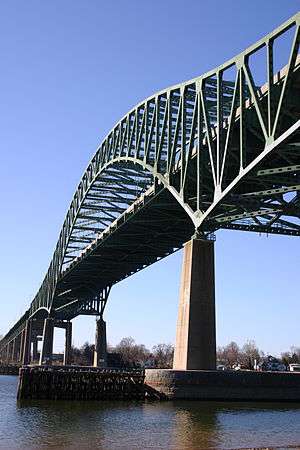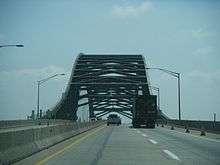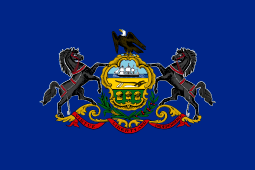Delaware River–Turnpike Toll Bridge
| Delaware River–Turnpike Toll Bridge | |
|---|---|
 Delaware River Turnpike Bridge from the east bank of the Delaware River | |
| Coordinates | 40°07′01″N 74°49′50″W / 40.11694°N 74.83056°WCoordinates: 40°07′01″N 74°49′50″W / 40.11694°N 74.83056°W |
| Carries |
4 lanes of |
| Crosses | Delaware River |
| Locale |
Bristol Township, Pennsylvania and Burlington Township, New Jersey |
| Official name | Delaware River–Turnpike Toll Bridge |
| Other name(s) | Delaware River Bridge |
| Maintained by | Pennsylvania Turnpike Commission and New Jersey Turnpike Authority |
| ID number | 097276990359000 |
| Characteristics | |
| Design | Steel Arch-Shaped Continuous Through Truss Bridge |
| Total length | 6,751 ft (2,058 m) |
| Width | 90 ft (27 m) |
| Longest span | 682 ft (208 m) |
| Clearance below | 135 ft (41 m) |
| History | |
| Constructed by | American Bridge Division of US Steel |
| Construction start | January 15, 1954 |
| Opened | May 25, 1956 |
| Statistics | |
| Daily traffic | 42,000 (2017) [1] |
| Toll |
Westbound: $6.75 toll-by-plate $5.00 E-ZPass[2] |
The Delaware River–Turnpike Toll Bridge is a four-lane, steel, arch-shaped, continuous truss bridge that connects the Pennsylvania Turnpike's East-West Mainline with the main trunk of the New Jersey Turnpike, via the Pearl Harbor Memorial Turnpike Extension (formerly known as the Pennsylvania Extension). The bridge crosses the Delaware River, connecting Bristol Township, Pennsylvania and Burlington Township, New Jersey.
History
The bridge was built by both the Pennsylvania Turnpike Commission (PTC) and the New Jersey Turnpike Authority (NJTA) when the PTC completed the "Delaware River Extension" of the Pennsylvania Turnpike between Valley Forge and Bristol Township in 1955, while the NJTA built the 118-mile (190 km) NJ Turnpike between Penns Grove and Ridgefield Park between 1950 and 1952. While the Pennsylvania Turnpike itself predates its New Jersey counterpart by over 10 years (the original Irwin-Carlisle section opened in 1940), the expansion of the Pennsylvania Turnpike to a cross-state highway was put on hold for the duration of World War II.
Starting with the upsurge of automobile traffic in 1946, the Pennsylvania Turnpike expanded from the original 110-mile (180 km) highway west from Irwin to the Ohio border and east from Carlisle to Valley Forge. At the same time, New Jersey, lacking a high-speed corridor, undertook the building of the New Jersey Turnpike under the auspices of then-Governor of New Jersey Alfred E. Driscoll. In order to provide a high-speed, low-interruption route from New York City to the Midwest, both the PTC and the NJTA undertook the building of the Delaware River–Turnpike Toll Bridge (known locally as the "Turnpike Connector Bridge") to connect the two highways. A local AAA chapter spearheaded a failed effort to have the bridge named after William Penn.
To maintain the "high-speed, low-interruption" characteristics ("low interruption" referring to the few stops needed to pay toll or fuel up at the numerous full-service plazas on both routes), the new bridge was designed from the beginning as a high-level crossing. This sharply contrasts with the Tacony–Palmyra Bridge and the Burlington–Bristol Bridge located downstream as they are both drawbridges, and are subject to frequent openings to allow large ships up and down stream (all other bridges downstream from the Delaware River–Turnpike Toll Bridge are high level crossings).
On January 3, 2016, the Pennsylvania Turnpike Commission implemented cashless tolling via either E-ZPass or TOLL BY PLATE, which uses automatic license plate recognition to take a photo of the vehicle's license plate and mail a bill to the vehicle owner. The toll is collected westbound only, as with the other bridges across the Delaware River.[3]
Maintenance

The Turnpike Connector bridge is operated jointly by the PTC and the NJTA, neither of which is subject to the interstate rules and regulations of the other dual-state authorities — Delaware River Port Authority (DRPA); Burlington County Bridge Commission (BCBC); Delaware River and Bay Authority (DRBA); and the Delaware River Joint Toll Bridge Commission (DRJTBC) — which operate nearly all other bridges across the Delaware River (except for the Dingman's Ferry Bridge, which is privately owned). Each state is responsible for its half of the bridge up to the state line (as evident in a recent redecking project in which the PTC redecked its half of the bridge with fresh concrete first, with the NJTA following later in a separate project).
In 2011, the NJTA and PTC undertook an investigation of the existing suspender system on the main span. Based on destructive testing of suspenders from the similar Newark Bay Bridge, consultants HNTB determined that the Delaware River bridge's suspenders had limited remaining service life and needed to be replaced. At each suspender location, the load from each original 4-inch-diameter (10 cm) wire rope was transferred into a set of four new 2-inch-diameter (5.1 cm) wire ropes, after which the original suspender was cut. The project was completed in August 2013.[4]
2017 closure
On January 20, 2017, the Delaware River–Turnpike Toll Bridge was closed after a fracture was discovered in a steel component.[5] On February 3, 2017, Pennsylvania Turnpike officials announced that the bridge would remain closed until at least April 2017.[6] The failure was located in a I-beam located approximately 80 ft (24 m) above ground on the Pennsylvania side and caused the bridge to drop by about 1 in (25 mm). Steel plates were installed as a temporary patch to stabilize the bridge and prevent further movement. The Assistant Chief Engineer for the Pennsylvania Turnpike Commission stated that ..."the crack likely was caused by a combination of factors, including age and plug welds that were commonly used in the 1950s to fill mistakenly drilled holes." [7] The bridge reopened to traffic on March 9, 2017, with unseasonably warm weather helping speed up work in repairing the bridge.[8]
Future construction
The final component of the direct interchange project between the Pennsylvania Turnpike and Interstate 95 in Bristol Township is the construction of a second, parallel span of the bridge that will be identical in appearance to the original 1956 span, similar in nature to the Delaware Memorial Bridge. This is necessary due to the increased traffic the bridge is expected to handle due to its re-designation as Interstate 95. As of early 2017, the new parallel span is not planned to begin construction until at least 2025.[9]
See also



- List of crossings of the Delaware River
References
- ↑ "UPDATE: Assessment of Delaware River Turnpike Bridge Continues". PA Turnpike. Pennsylvania Turnpike Commission. Retrieved 24 January 2017.
- ↑ "Pennsylvania Turnpike Delaware River Bridge Toll Rate Schedule" (PDF). Pennsylvania Turnpike Commission. Archived from the original (PDF) on August 2, 2017. Retrieved 2017-08-02.
- ↑ Behrman, Elizabeth (January 1, 2016). "Toll over Pennsylvania Turnpike's Delaware Bridge will be cashless". Greensburg Tribune-Review. Retrieved January 3, 2016.
- ↑ Schaefer, Richard; Zoli, Theodore P.; Tatoris, Ana (February 2014). "Switching Suspenders". Civil Engineering. American Society of Civil Engineers: 66–71, 78.
- ↑ "Delaware River Bridge closed due to structural problem". Philadelphia, PA: WPVI-TV. January 20, 2017. Retrieved January 20, 2017.
- ↑ "Delaware River Bridge closed until at least April". Philadelphia, PA: WPVI-TV. February 3, 2017. Retrieved February 3, 2017.
- ↑ "Team Temporarily Stabilizes Delaware River Bridge Crack". Engineering News Record (Volume 278 Number 4). bnp media. February 6, 2017. p. 15. ISSN 0891-9526.
- ↑ "Delaware River Turnpike Bridge set to reopen tonight". Philadelphia, PA: WPVI-TV. March 9, 2017. Retrieved March 9, 2017.
- ↑ Pennsylvania Turnpike Commission. "Parallel Delaware River Bridge". Retrieved 2017-01-23.
External links
| Wikimedia Commons has media related to Delaware River – Turnpike Toll Bridge. |
